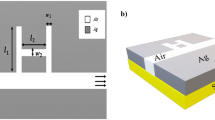Abstract
In a very recent work, a transverse electric peak-type metal-clad waveguide optical sensor was proposed in which a double-negative material (DNM) was used as a guiding layer. The sensor was found to exhibit a considerable angular shift of the reflectance peak for small changes in the refractive index of the analyte, due to the DNM layer. In this work, the optimization of the structure parameters is investigated to find out the most appropriate metal and its optimal thickness. Moreover, the optimal DNM layer parameters corresponding to the highest sensitivity are explored. Our calculations reveal that metals with high absolute value of the real part of the permittivity correspond to sharper peaks. Moreover, as the absolute value of the real part of both ε and μ of the DNM increases, the reflectance peak becomes sharper and the dip following the peak becomes deeper.








Similar content being viewed by others
References
H.M. Kullab, S.A. Taya, Int. J. Electron. Commun. (AEÜ) 67, 905 (2013)
H.M. Kullab, S.A. Taya, Optik 145, 97 (2014)
N. Skivesen, R. Horvath, H. Pedersen, Sens. Actuat. B 106, 668 (2005)
N. Skivesen, R. Horvath, H. Pedersen, Opt. Lett. 30, 1659 (2005)
G. Tollin, Z. Salamon, Biophys. J. 80, 1557 (2001)
Z. Salamon, G. Lindblom, G. Tollin, Biophys. J. 84, 1796 (2003)
M. Zourob, N. Goddard, Biosens. Bioelectron. 20, 1718 (2005)
E. Kretchmann, H. Reather, Z. Naturforsch. A 23, 2135 (1968)
V. Veselago, Sov. Phys. Usp. 10, 509 (1968)
R.A. Shelby, D.R. Smith, S. Schultz, Science 292, 77 (2001)
D.R. Smith, N. Kroll, Phys. Rev. Lett. 85, 2933 (2000)
R. Ruppin, Phys. Lett. A 227, 1811 (2000)
K. Park, B.J. Lee, C. Fu, Z.M. Zhang, J. Opt. Soc. Am. B 22, 1016 (2005)
S.A. Taya, H.M. Kullab, I.M. Qadoura, J. Opt. Soc. Am. B 30, 2008 (2013)
S.A. Taya, E.J. El-Farram, M.M. Abadla, Optik 123, 2264 (2012)
S.A. Taya, I.M. Qadoura, Optik 124, 1431 (2013)
I.M. Qadoura, S.A. Taya, K.Y. El-wasife, Int. J. Microw. Opt. Technol. (IJMOT) 7, 349 (2012)
J.B. Pendry, Phys. Rev. Lett. 85, 3966 (2000)
A. Grbic, G.V. Eleftheriades, Appl. Phys. Lett. 82, 1815 (2003)
D.K. Qing, G. Chen, Appl. Phys. Lett. 21, 669 (2003)
A. Alu, N. Engheta, Phys. Rev. E 72, 016623 (2005)
H.M. Kullab, S.A. Taya, T.M. El-Agez, J. Opt. Soc. Am. B 29, 959 (2012)
L. Shen, J. Qiu, Z. Wang, Progress In Electromagnetics Research Symposium Proceedings, Suzhou, China, pp. 1043–1048, (2011)
O. Voskoboynikova, G. Dyankova, C.M. Wijersb, Microelect. J. 36, 564 (2005)
Author information
Authors and Affiliations
Corresponding author
Rights and permissions
About this article
Cite this article
Taya, S.A., Kullab, H.M. Optimization of transverse electric peak-type metal-clad waveguide sensor using double-negative materials. Appl. Phys. A 116, 1841–1846 (2014). https://doi.org/10.1007/s00339-014-8338-y
Received:
Accepted:
Published:
Issue Date:
DOI: https://doi.org/10.1007/s00339-014-8338-y



